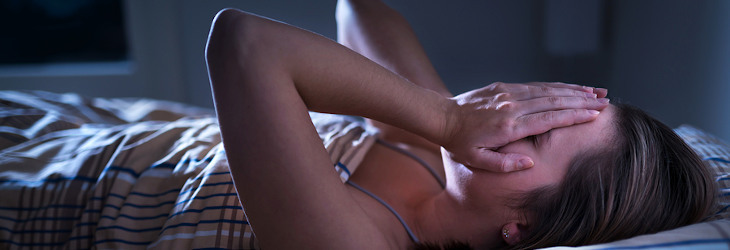Dry eyes can be a frustrating condition, especially when symptoms worsen at night. Many people experience increased discomfort, redness, and irritation in the evening or before bed, which can even impact sleep quality. Understanding the factors that contribute to nighttime dry eye symptoms is crucial for finding effective relief.
Why Dry Eyes Get Worse at Night
Throughout the day, our eyes are exposed to various irritants that can trigger or exacerbate dry eye symptoms.1 Additionally, tear production naturally decreases at night, which can worsen pre-existing dry eye conditions.2 This combination of factors often leads to more severe symptoms in the evening and throughout the night.
Nighttime dry eye symptoms can significantly impact sleep quality, creating a vicious cycle as poor sleep is another risk factor for dry eyes. Addressing these symptoms is essential for both eye health and overall well-being.
Common Nighttime Dry Eye Symptoms
Dry eye symptoms at night are similar to those experienced during the day but may be more intense. Common signs include:
- Redness and irritation
- Burning or itching sensation
- Feeling of having sand or grit in the eyes
- Swollen eyes or eyelids upon waking
- Sticky eyelashes and eyelids
- Increased eye discharge or crusty debris (commonly known as “sleep” or “eye boogers”)
Effective Treatments for Nighttime Dry Eyes
Treating nighttime dry eye symptoms involves a combination of addressing underlying causes and implementing targeted therapies. Some effective strategies include:
1. Identify and Treat Underlying Health Conditions
Certain health conditions, such as diabetes and hypothyroidism, can contribute to the development of dry eyes.3,4 Properly managing these conditions can help alleviate dry eye symptoms. Additionally, some medications, like antidepressants, may cause dry eyes as a side effect. Discussing alternative treatments with your doctor may be beneficial.
2. Minimize Environmental Irritants
External factors, such as dry air, contact lens wear, and prolonged screen time, can exacerbate dry eyes.5,6 Using a humidifier, limiting contact lens wear, and taking frequent breaks during screen time can help minimize irritation. Software that reminds you to blink regularly can also help maintain eye surface moisture.
3. Use Nighttime-Specific Eye Drops, Gels, or Ointments
Certain eye drops, gels, and ointments are specifically formulated for nighttime use. These products often have a higher viscosity, allowing them to remain on the eye surface longer and provide extended relief. Look for products containing ingredients like carbomers, cellulose derivatives, or a high concentration of hyaluronic acid (0.4% or more).7,8,9,10
4. Apply a Humid Eye Mask
If your dry eye symptoms are primarily due to incomplete eyelid closure during sleep, using a wet compress or humid eye mask can help. These masks prevent tear evaporation and provide external moisture to the eye surface, promoting a more stable tear film.11
5. Optimize Your Sleep Environment
Ensuring your bedroom has adequate humidity can help prevent dry eyes. If you spend a significant amount of time in air-conditioned or heated spaces, consider using a humidifier to add moisture to the air, particularly in your sleeping area.
The Importance of Addressing Nighttime Dry Eyes
Dry eyes are more than just an annoyance; left untreated, they can worsen and lead to further complications. If you experience persistent dry eye symptoms at night, it’s essential to take proactive steps to alleviate discomfort and promote eye health. By implementing a combination of the strategies outlined above, you can find relief from nighttime dry eye symptoms and improve your overall quality of life.
References
1. Dry Eye. https://www.aoa.org/patients-and-public/eye-and-vision-problems/glossary-of-eye-and-vision-conditions/dry-eye. Accessed October 25, 2019.
2. Ayaki M, Tachi N, Hashimoto Y, Kawashima M, Tsubota K, Negishi K. Diurnal variation of human tear meniscus volume measured with tear strip meniscometry self-examination. PLOS ONE. 2019;14(4):e0215922. doi:10.1371/journal.pone.0215922
3. Zhang X, Zhao L, Deng S, Sun X, Wang N. Dry Eye Syndrome in Patients with Diabetes Mellitus: Prevalence, Etiology, and Clinical Characteristics. Journal of Ophthalmology. 2016;2016:1-7. doi:10.1155/2016/8201053
4. Kan E, Kılıçkan E, Ecemiş G, Beyazyildiz E, Çolak R. Presence of Dry Eye in Patients with Hashimoto’s Thyroiditis. Journal of Ophthalmology. 2014;2014:1-4. doi:10.1155/2014/754923
5. Kojima T. Contact Lens-Associated Dry Eye Disease: Recent Advances Worldwide and in Japan. Investigative Opthalmology & Visual Science. 2018;59(14):DES102. doi:10.1167/iovs.17-23685
6. Freudenthaler N, Neuf H, Kadner G, Schlote T. Characteristics of spontaneous eyeblink activity during video display terminal use in healthy volunteers. Graefe’s Archive for Clinical and Experimental Ophthalmology. 2003;241(11):914-920. doi:10.1007/s00417-003-0786-6
7. DeLuise VP, Peterson WS. The use of topical Healon tears in the management of refractory dry-eye syndrome. Annals of ophthalmology. 1984;16(9):823-824. http://www.ncbi.nlm.nih.gov/pubmed/6508097. Accessed November 21, 2019.
8. Guillaumie F, Furrer P, Felt-Baeyens O, et al. Comparative studies of various hyaluronic acids produced by microbial fermentation for potential topical ophthalmic applications. Journal of Biomedical Materials Research Part A. 2009;9999A:NA-NA. doi:10.1002/jbm.a.32481
9. Verma DrS. Polymers in designing the mucoadhesive films: A comprehensive review. International Journal of Green Pharmacy. 2018;12(2). doi:10.22377/IJGP.V12I02.1783
10. Solomonidou D, Cremer K, Krumme M, Kreuter J. Effect of carbomer concentration and degree of neutralization on the mucoadhesive properties of polymer films. Journal of Biomaterials Science, Polymer Edition. 2001;12(11):1191-1205. doi:10.1163/156856201753395743
11. Kurihashi K. Moisture Aid during Sleep for the Treatment of Dry Eye: Wet Gauze Eye Mask. Ophthalmologica. 1994;208(4):216-219. doi:10.1159/000310492

